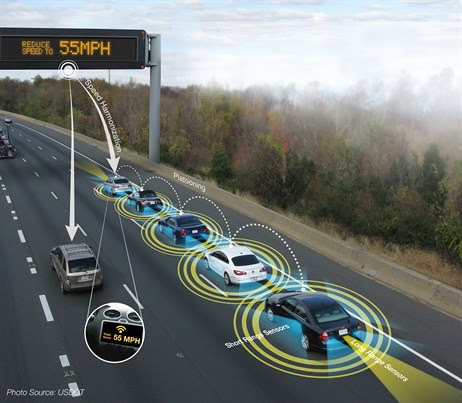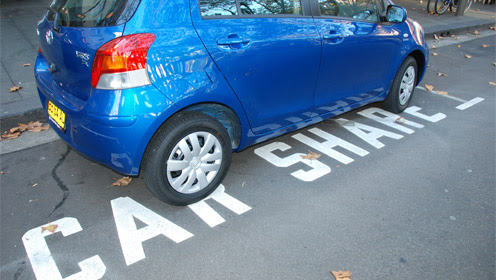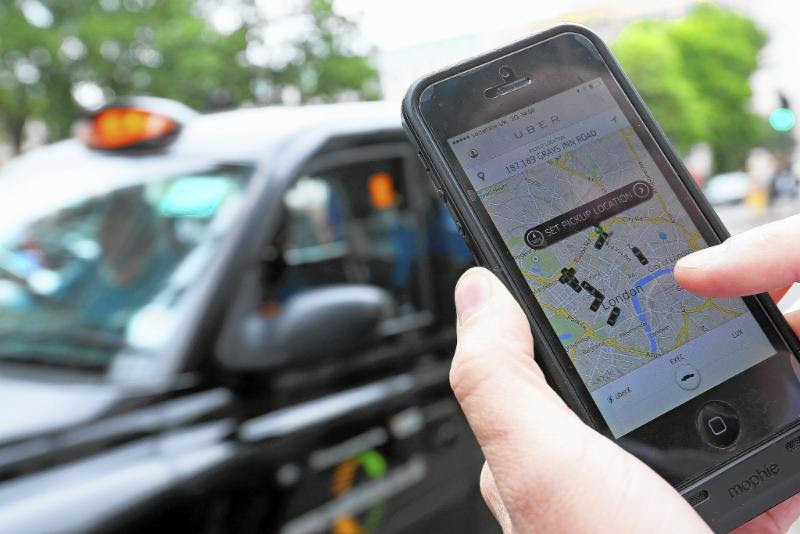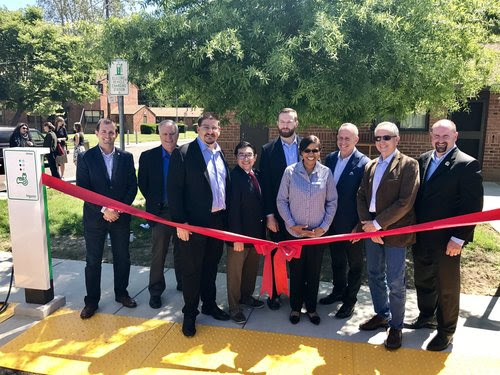Encouraging ridesharing and carsharing is a strategy that would address current conditions and lay the groundwork for a brighter autonomous-vehicle future.
Creating a utopia for self-driving cars? Start sharing the ride now!
Mobility is vitally important in today’s economy, and bringing zero-emission transportation options to all residents is critical to protecting air quality and health.
– Larry Greene, formerly Sacramento’s AQMD’s Executive Director

Car manufacturers expect to have autonomous vehicles on the road within the next three to five years. Some experts predict that, with the rapid increase in adoption of new technology, there could be 10 million self-driving cars on the road by 2020, with one in four cars being self-driving by 2030. (Approximately 264 million cars were registered in the U.S. in 2015.)
Research by UC Berkeley Director of Institute of Transportation Studies, Joan Walker has estimated that autonomous vehicles could increase vehicle miles traveled by 6% to 90%, depending on the percent of individually owned (versus shared) cars. More than one-half (52%) of people surveyed said they would use an autonomous vehicle, while only 20% said they would share. Survey respondents were willing to pay a $4,900 premium on average, which would be in the range of the added cost for an autonomous vehicle.
With the scale of growth by transportation network companies such as Uber and Lyft, communities would be wise to take proactive steps now to nudge the market to optimize community benefits. Encouraging ridesharing and carsharing is one strategy that would address current conditions and lay the groundwork for a brighter autonomous-vehicle future with lower car ownership, less traffic congestion, cuts in greenhouse gas emissions, and reduced car-related infrastructure.
CARS AT REST. The average car spends 95% of its time sitting in place – an average of 23 hours a day. And when our cars are in motion, 80% of seats on the road are currently empty. Plus, Americans waste 5.5 billion hours each year due to road congestion.

SMART INVESTMENTS. Given our substantial national infrastructure deficit ($3.2 trillion through 2020), local governments would be wise to consider optimizing and improving current transportation infrastructure before making investments in new streets and parking to support mobility needs that are rapidly changing.
MIT scientists found that if the trend toward ride-sharing keeps accelerating, traffic congestion could be reduced by 37% and the number of vehicles on the road decreased by 19% (assuming half of drivers shifted over to ridesharing).
Through the 1960s and into the mid-1970s, one in five workers carpooled to their jobs. Today, 85% of Americans drive to work alone, fewer than one in 10 shares a ride to work.
Even more troubling, per capita VMT in 2015 and 2016 rose by more than 2% – after a 10-year decline in driving that began in 2004. That increase is a higher rate than at any time in the past quarter-century.
Even if electric cars are able to scale to meet state and federal goals, communities will still suffer from more traffic congestion, growing infrastructure costs and widening sprawl development that degrades natural resources.
Luckily, communities are taking proactive steps to encourage carshare and rideshare.
Sacramento launches carshare for low-income residents
Carshare can be a great way to better use vehicles and acclimate people to a shared autonomous-vehicle future. The number of carshare vehicles in the U.S. has risen three-fold from fewer than 700 in 2003 to more than 19,000 in 2014 (Shaheen and Cohen, 2014).
A new program targeting low-income commuters, “Our Community CarShare Sacramento,” provides residents of three Sacramento public-housing complexes (Mutual Housing at Lemon Hill, Alder Grove Housing Complex and Edge Water Housing Complex) with free access to eight electric Kia Souls. It is the first zero-emission carsharing program to launch in California.
The communities’ 2,000 residents will be able to reserve the electric vehicles at self-service kiosks on-site. Zipcar, the world’s largest carsharing service, powers the reservation system and will maintain the fleet. There will be no cost for residents to use these cars. Six of the zero-emission vehicles are stationed at the residential communities, with two additional vehicles available for reservation by registered users at the Sacramento Valley Light Rail Station.
The California Air Resources Board provided a $1.3 million grant to the program through California Climate Investments (cap-and-trade proceeds).

Bay Area jurisdictions add new carpooling apps
Ridesharing can help fill those 80% empty car seats currently on the road, reduce congestion, trim costs for drivers and riders alike, and help people become more accustomed to a transportation future that relies on shared fleets and on-demand service.
In May, the Contra Costa Transportation Authority began a new partnership with San Francisco-based Scoop Technologies, Inc. to incentivize residents ($2 per ride) to use its carpooling app during weekday drive times. They join Foster City, Pleasanton and San Mateo who all have similar pilots. In 2016, Palo Alto and Santa Clara County also subsidized carpooling through Scoop. Santa Clara County offered 17,000 county workers carpool rides to and from work for just $1 each way through their mobile app.
Users sign up for a ride in the morning and evening commutes, and the firm’s app then assigns them to a car pool. Scoop conducts vehicle-history checks through Checkr, the online background-check service used by Uber. Anyone can use the service, but Scoop specifically contracts with cities, counties and businesses to make it easier and cheaper for employees to participate.
Since 2015, commuters using the company’s app have taken more than 650,000 trips, eliminating nearly 1.8 million travel miles and lowering carbon emissions by 1.3 million pounds. Santa Clara County is currently offering discount codes for users of Scoop and carpool apps Carzac and Duet.

Lyft and Uber are also offering shared-ride services – Lyft Line and Uber Pool – in select cities. According to Lyft’s Emily Castor, 40% of passengers choose Lyft Line (begun in 2014) in their 15 largest markets. The main motivating factor is the reduced price between individual and shared trips.
Both companies are partnering with employee-benefit services to allow people who receive pretax transportation benefits through their employers to use that money for carpooling trips – saving commuters up to 40% on their carpooling trips.
Lyft is partnering with WageWorks, Zenefits, Benefit Resource, Commuter Benefit Solutions and Navia to allow residents in New York City, Boston, Seattle and Miami to use pretax dollars to pay for Lyft Line trips to and from work. Uber has a similar partnership with WageWorks for employees who live in New York City, Philadelphia, Chicago and San Francisco.
In June, Google’s Waze, known for the traffic navigation app, launched a carpooling app statewide that lets drivers offer rides to people traveling on a similar route. Passengers who want to carpool with a driver will be able to download the separate Waze Carpool app and request a ride.
Unlike Uber and Lyft, Waze Carpool riders chip in only to cover the cost of gas (there won’t be a commission from each ride or drivers that use it as a source of income), which will hopefully result in affordable rides for passengers and gas money/carpool lane privileges for drivers.
Waze has been testing the service in the San Francisco Bay Area and Israel for the last year.
Riders will pay no more than the IRS’ mileage-reimbursement rate of 54 cents per mile, all of which will go to the driver. At the time of the statewide launch, Waze will not take a commission.
Maximizing the potential of ridesharing
Communities can take a number of steps to take advantage of the growing ridesharing opportunities that smartphone and vehicle technology can provide.

In its report “Smart mobility: Reducing congestion and fostering faster, greener, and cheaper transportation options,” Deloitte Services LLP identified several strategies that could help to spur carpooling’s resurgence:
- Expand tax incentives to ridesharing:Extending the employee pre-tax benefits commonly available for parking, transit passes and vanpool costs to ridesharing could increase its appeal to commuters.
- Enhance the customer experience of ridematching platforms:Cities should determine how best to marshal private-sector innovation to bring first-class user interfaces, highly reliable service, incentives for participation and widespread public awareness to ridematching.
- Use infrastructure investments to support ridesharing:Most commuters who carpool are motivated principally by the time or money they can save by doing so. Ridesharing initiatives should be included in high-occupancy vehicle (HOV) and high-occupancy toll (HOT) lane projects, along with designated commuter lots to facilitate convenient passenger pickup and dropoff via dedicated entrance and exit ramps.
- Focus on building a critical ridesharing mass in key corridors: Rather than trying to expand ridesharing across a wide region, this approach would have a quicker impact. A base level of “guaranteed” service (meaning that a commuter will always be guaranteed a carpool on a corridor) is likely needed to generate repeat users until a critical mass is achieved. Many cities already have guaranteed ride-home programs, which typically offer vouchers to pay for a taxi if members miss their vanpool. Such programs should be tied to real-time ridesharing initiatives to help provide a guaranteed service level until the corridor network is dense enough to achieve stable critical mass.
- Recruit participants through trusted channels:Recruiting efforts tend to be most effective when they involve trusted channels, such as employers. New-employee orientations, for instance, represent an effective channel for enhancing the awareness of ridesharing as a viable commuting option.
- Target younger commuters:Recent years have seen significant shifts in attitudes toward carsharing, especially among millennials: 42% of Generation Y consumers say they are willing to carpool if it is readily available and convenient.
- Establish public-private partnerships to improve mobility:Forward-thinking jurisdictions could adopt pay-for-success models that specify particular mobility outcomes rather than the means by which those outcomes are to be achieved. Doing so could open up new kinds of partnerships with automakers, ridesharing companies and others exploring new mobility services and help stimulate innovative methods for reducing gridlock in some of the most congested corridors.
These strategies are relatively cheap compared to major infrastructure changes and are likely to offer a significant return on investment for state and local transportation systems.
Cities have also implemented congestion pricing – requiring drivers to pay extra fees to travel in congested downtowns unless they are in rideshared cars – which would help discourage single-occupancy (or in the future zero-occupancy autonomous cars). London’s program saw a 30% reduction in congestion in the first years, a substantial increase in transit ridership and bicycling, fewer traffic fatalities and significant revenue ($222 million in 2008, the majority of which went into improving bus service).
Shared autonomy drives future for community benefits
Opinions vary widely around the timing and the impacts of autonomous cars but one thing is certain: There are practical steps that local governments can take now to secure immediate benefits and nudge the market in a direction that provides greater community benefits in the future.
Local Government Commission Newsletters
Livable Places Update
CURRENTS Newsletter
CivicSpark™ Newsletter
LGC Newsletters
Keep up to date with LGC’s newsletters!
Livable Places Update – April
April’s article: Microtransit: Right-Sizing Transportation to Improve Community Mobility
Currents: Spring 2019
Currents provides readers with current information on energy issues affecting local governments in California.
CivicSpark Newsletter – March
This monthly CivicSpark newsletter features updates on CivicSpark projects and highlights.



